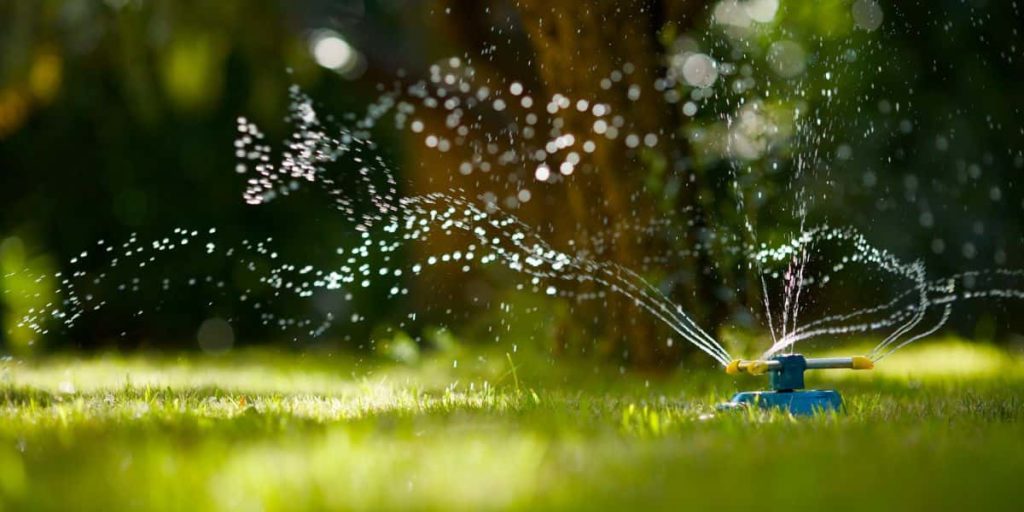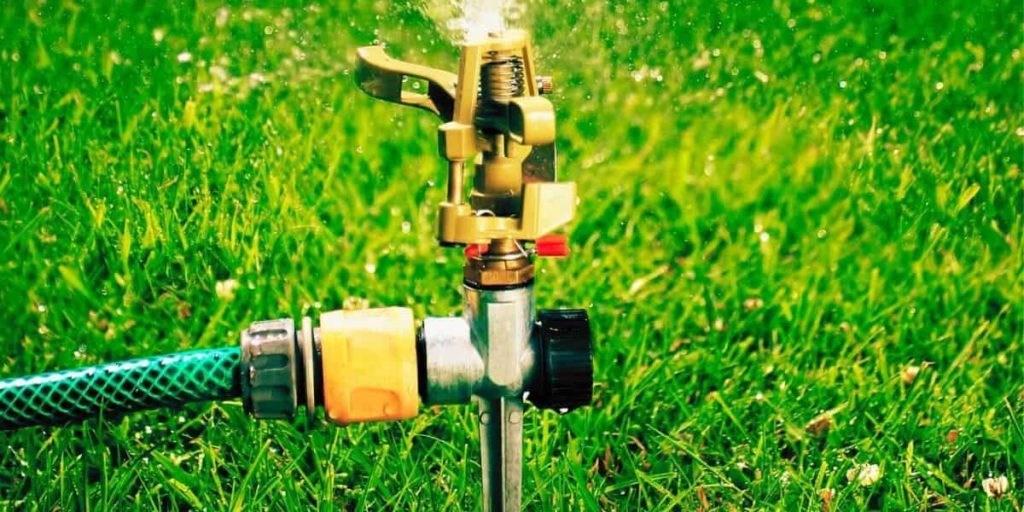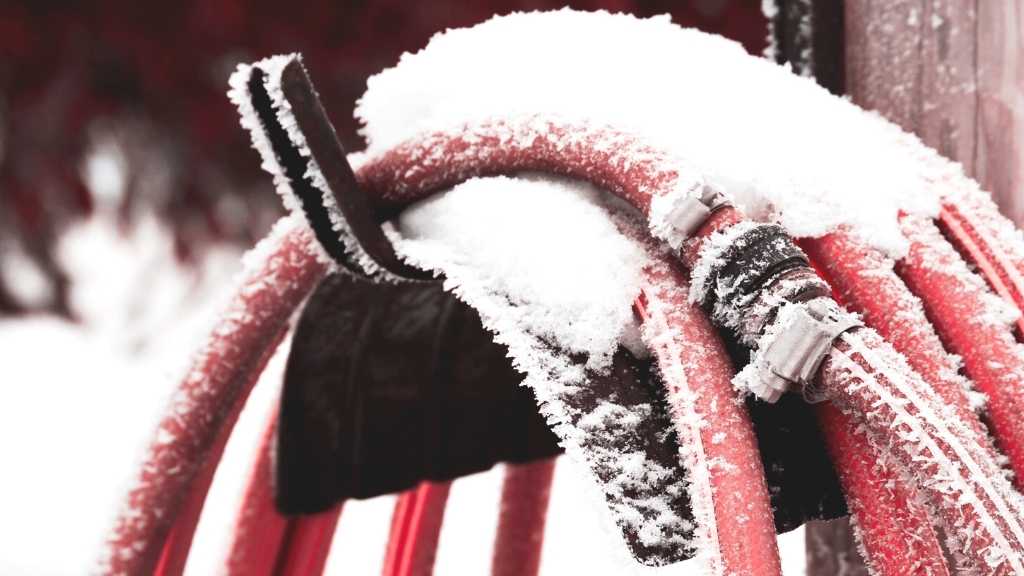One of the topics that we frequently discuss and research is the lawn. How to take care of it, how to make sure it remains healthy year-round, how to mow and water it, and when is the best time for doing any of these maintenance actions.
But in this post, we intend to shortly cover some quick solutions for lawn watering. We will cover the types of sprinkler irrigation available and the specific ways of using sprinklers with garden hoses. Another part of the post will be dedicated to injecting fertilizer while irrigating. Make sure you keep reading to not miss any details!
Besides mowing, which may require a bit of time to master, watering the lawn can become very time-consuming if you don’t have any irrigation setup yet. Installing an irrigation system can seem an overwhelming action when you first start your research. But once you get a general idea, it is not so complicated after all. In case you don’t intend to install a complicated underground irrigation system for your lawn, the above-ground sprinkler system irrigation that we are about to detail in the rest of the post might be a good solution for you.
More specifically, we will talk about how to make a sprinkler system using a normal garden hose.
The simple way to make a sprinkler system using a garden hose is by creating an above-ground irrigation system. There are two different types of sprinkler systems that are installed above ground:
- Portable sprinkler irrigation system. It is simple to set up. Just attach a sprinkler end to the garden hose. Then move the sprinkler to different areas of your yard until all the surface is covered.
- Fixed sprinkler irrigation system. The setup is easy to medium, as a level of difficulty. You must make a lawn layout design first. Then calculate the correct distance between the sprinklers and determine how many sprinklers you need. Plan where to install each sprinkler head to ensure the proper coverage of the entire lawn surface.
Depending on which type of irrigation better suits your needs, below are the main parts you will need to build your own sprinkler irrigation system.
Portable Sprinkler System

- A garden hose
- An automatic oscillating sprinkler with 360-degree rotating arms
- Quick Connect Garden Hose Fittings
- Hose splitter connector- optional in case you want to run more sprinklers at the same time.
To install this type of irrigation system, simply attach the oscillating sprinkler to your garden hose. For this, we recommend using quick connect hose fittings.
Lay the sprinkler on the lawn and turn on the water from your faucet. Do some tests until you make sure the water covers the correct lawn area.
In case you need to set up more than one sprinkler, you can use a hose splitter connector on your faucet. Then attach a second or third hose directly to the faucet. On the opposite ends of the hoses attach the respective oscillating sprinklers. Distribute the sprinklers on the other areas of the lawn and turn on the water. Do similar tests as before, to make sure the entire surface is covered by the sprinkler jet.
Fixed Sprinkler System

- A hose cutting tool or a pair of pruning shears
- Quick Connect Garden Hose Fittings
- A garden hose
- Sprinkler heads of your own choice, usually impact sprinklers
- Garden sprinkler spikes with inbuilt thread fittings
- Cap end fittings
- Garden stakes for hoses – optional
The installation of this type of irrigation system is a bit more complex than the portable sprinkler system, described above.
A. Carefully analyze the shape of the area that needs watering. Pay attention to how wide and long that area is. This will determine how many sprinklers you would need and where to better position each of them.
B. Measure the length between the hose bib and the spot where you need to position the first sprinkler.
C. Grab your garden hose and cut the same length from it, using a hose cutting tool.
D. Attach a quick-connect hose fitting to the new end of the garden hose. Then attach this end to the sprinkler spike.
E. Attach the sprinkler head to the spike and insert the spike into the ground. Each sprinkler spike has two inbuilt threaded hose connector ends.
F. Move on to the next section of the irrigation line by cutting a new piece of garden hose. This new piece of the hose must cover the necessary length between the first and the second sprinkler head.
G. Hook up quick connectors at both ends of the new piece of hose.
H. Attach the hose on one end to the second hose connector fitting from the first spike. On the other end attach it to one of the hose connectors from the second sprinkler spike.
I. Continue this process until all the sprinkler spikes are installed.
J. On the second end of the last spike attach a cap end fitting.
You can use hose ground stakes to make sure the garden hose remains in a fixed position.
Can I Connect a Hose To a Sprinkler Head?
Connecting a sprinkler head to the garden hose can be quickly done with a simple set of hose quick connectors.
Most sprinkler heads have ½ inch thread which easily connects to the ½-inch threaded fitting on the garden sprinkler spikes. The garden hose should be attached to the sprinkler spike using a quick connector hose fitting.
The automatic oscillating sprinklers have an inbuilt standard size ¾ inch threaded fitting. You can easily attach this type of sprinkler to the garden hose using ¾ quick connector hose fitting.
Can I Use Sprinkler Riser Heads With Garden Hoses?
Sprinkler riser heads normally need more water pressure than ground-level sprinklers. Moreover, if the sprinkler height is more than a few inches. Connecting such sprinkler to the normal garden hose is doable with a few side notes.
In case you use standard ground-level sprinklers, but you also want to have one or more sprinkler riser heads installed in the irrigation system, use a second garden hose for the sprinkler riser heads. This is needed to maintain proper water pressure in your irrigation system.
You can attach more hoses to the faucet using a hose splitter connector and attach separate hoses to the overhead sprinklers. Choose to separately run the water for these sprinklers, to make sure you have the proper water pressure in the system.
Another issue with using hoses, instead of standard irrigation pipes for the sprinkler riser head, is the sprinkler stability. A good option is to attach the sprinkler head directly to the hose, using the hose quick connect fittings.
Then find an old pipe that has the proper height and sturdiness that you need. Use it as holder support for the hose. Bury it a few inches into the ground, in the area where you need the sprinkler to run. Then attach the hose with the installed sprinkler head to the pipe, using adjustable plastic clamps.
What Garden Hose Diameter Should I Use For Multiple Sprinklers?
As we mentioned, standard garden hoses can be used to run a sprinkler system. But the number of sprinklers that are included in the irrigation line is important. This number has an impact on the irrigation system. When you use too many sprinklers the water might not properly run throughout the line.
Therefore, when it comes to installing multiple sprinklers into an irrigation line, the water pressure and water flow rate from your hose bib are more important variables than the garden hose diameter.
To ensure you are not connecting more sprinklers than what the system can support, some calculations are necessary.
First, on the sprinkler heads package label you will find important information provided by the manufacturer such as the PSI (water pressure) range and the GPM (water flow rate) range. These are the indicated tiers where the sprinkler will properly function.
To measure the PSI available at the hose bib you can use a simple pressure meter (gauge). Attach the gauge to the hose bib and turn on the water supply. This will tell you how much pressure you have available.
Write this information down and then determine the water flow rate available at the faucet.
To determine the available water flow rate, you need a five-gallon bucket and a timer. Turn on the faucet at the maximum level. Then use a timer to see how long it takes for the bucket to fill in with water.
To determine the water flow rate in gallons per minute, the below calculation can be used.
For demonstration, we will consider the 5-gallon bucket was filled with water in 30 seconds.
5 (gallon bucket capacity) x 60 (seconds in a minute) = 300
300 / 30 (second to fill the bucket) = 10 (GPM – gallons per minute)
Once you planned the layout of the irrigation system and determine how many sprinkler heads you will need to install, sum up all the PSI or GPM of the sprinkler heads.
In this case, we only know the GPM therefore, if the total GPM of all the sprinkler heads is below 10 GPM then your water supply can ensure the proper functioning of all the sprinklers.
If the total is above the 10 GPM, then you might consider using a second hose bib for the additional sprinkler heads.
Can I Run Inground Sprinklers From a Garden Hose?
The short answer to this question is Yes, there are some sprinkler models available, such as Quick Snap sprinklers. These are installed by directly burying them into the ground a few inches deep. They come with a preinstalled hose adaptor that remains above the ground surface. You can simply attach the garden hose to it, whenever you want to water that specific lawn or garden area.
How to Inject Fertilizer Into a Garden Hose Sprinkler
It is possible to easily fertilize the lawn while watering it. This can be achieved by using a fertilizer injector.
This injector connects directly to the hose bib or to the water timer on one side, and to the garden hose on the other end. The fertilizer injector is connected easily through its inbuilt standard hose connectors.
It includes a PVC tank which you fill in with the specific lawn fertilizer. They work with any water-soluble or liquid fertilizers. Another plus is that the injector also includes an adjustor for the fertilizer ratios that you need to use. The correct ratios are detailed by the manufacturer on the fertilizer package label.
Conclusion
Garden hoses have multiple uses and can be connected differently, for different purposes. In this post, we described how a simple garden hose can be used in building a sprinkler irrigation system.
No matter if you need a portable irrigation system or a fixed one, your standard garden hose can be used in each scenario.
We hope you find this information useful and that some of these processes will help in your specific situation.



